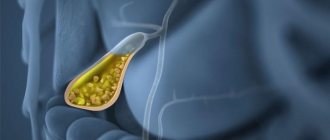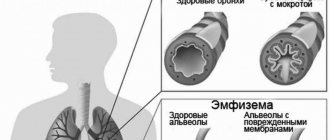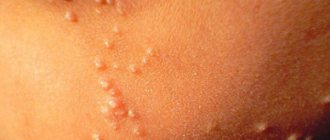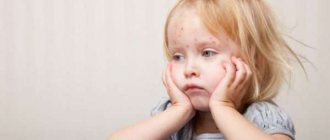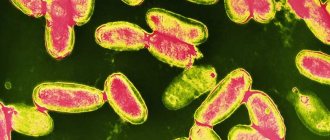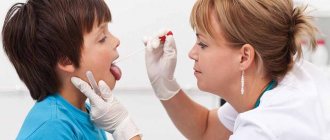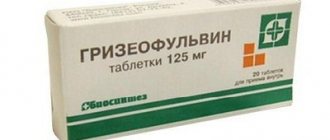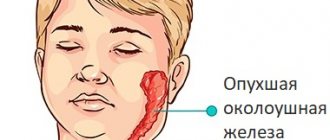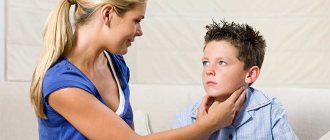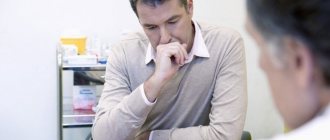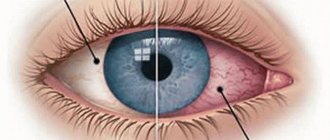- Causes
- Symptoms
- Diagnostics
- Treatment
- Peculiarities
- Main
- Video
Ringworm in the everyday understanding is an inflamed, scaly spot or group of spots. In medicine, lichen refers to several dermatological diseases of the group of infectious erythema, most often of a fungal nature and caused by excessive growth of the epithelium . Examples include ringworm, also known as microsporia, and pityriasis versicolor, better known as tinea versicolor or versicolor. There are other skin diseases, also called lichen, in the occurrence and development of which microscopic fungi are not involved - these are lichen planus and lichen rosea, which experts call Zhiber's disease (synonym - roseola exfoliating, pityriasis).
Pityriasis rosea is not the most common disease, affecting mainly young people, as well as children and adolescents. In infants, pityriasis rosea is diagnosed extremely rarely, as well as in people who have crossed the forty-year mark. The causes of the disease are not fully understood, although dermatologists agree that it is based on allergies, infections and improper skin care. It is clear that patients are interested in: is pityriasis rosea contagious? Experts say that this disease, like many others of an allergic nature, such as dermatitis, is not contagious . However, in most cases, the impetus for the development of Zhiber's lichen is given by an infection, including an acute respiratory infection (in common parlance - a cold) - a patient with pink lichen can transmit it to the people around him . It is no coincidence that the increase in the incidence of pityriasis rosea occurs in autumn and spring, that is, the time of external temperature fluctuations and the acute respiratory diseases provoked by them, as well as influenza.
What is pityriasis rosea
The disease, otherwise called roseola flaky or pink pityriasis, is a disease from the group of dermatological diseases, which is based on allergic and infectious components, and is accompanied by the formation of reddish spots on the entire surface of the skin. Lichen received its main name - Gibert's disease - in honor of the French scientist and dermatovenerologist. Camille Gibert devoted many years of his life to describing and researching the clinical picture and diagnosis of the disease . Today it is known that the disease affects both men and women. The most vulnerable categories of the population are the elderly and young children: their immunity is weakened enough to not prevent the pathogen from entering the body and multiplying.
Lichen Zhibera is a fairly typical disease that occurs in everyone’s favorite pets. Cats and dogs are susceptible to the disease. It is known that the main reason for the development of lichen in pets is low immunity. This is directly related to the living conditions of the cat or dog, diet, places to walk and contact with wild stray animals. The disease begins to spread over the surface of the skin, leaving bald patches of fur.
Photo gallery: manifestations in animals
The dog's chin and skin fold area are involved in the process.
The first spots appear on the face
The disease may affect the ears
The causative agent of the disease and the basis for the occurrence of the disease
After many years of research, scientists have come to the conclusion that pityriasis rosea can be caused by two types of herpes viruses: the sixth and the seventh. Both of these pathogens contain a DNA molecule that is introduced into the human body. Normally, more than half of the globe is infected with herpes viruses, but for people with a healthy and active immune system, it is completely harmless and resides in the body as a completely harmless microorganism.
The virus has an envelope that protects its DNA from the action of the body's protective factors
If the patient suffers for a long time from a serious illness, which leads to a decrease in the functions of the immune system and a disruption in the production of protective cells (macrophages, lymphocytes, T-killers and T-helpers), conditions are created for the favorable growth and development of herpes in the body. Most often, penetration occurs in the area of the thinnest and most delicate skin (pubis, groin area, armpits, face, inner thigh). The virus penetrates epithelial cells and begins to actively multiply, releasing toxins - this contributes to the formation of maternal plaque on the integument of the human body. Due to the breakdown products of substances produced by herpes during the reproduction process, unbearable itching of the skin develops. The patient, without knowing it, gradually spreads it throughout the body when scratching. Over time, the rash becomes localized over a larger surface of the body and can also affect the scalp.
The rash begins from a single maternal plaque
Is pityriasis rosea contagious or not?
Experts assure that this disease is very contagious; it is easily transmitted from person to person through the use of common household items. Nevertheless, as practice shows, pityriasis rosea more often affects the body of those people who have weakened immunity. These patients include children and elderly people. A separate towel and other household items should be used if one of the family members has contracted the disease.
Maternal plaque in rosacea
How to correctly classify a disease
In modern dermatovenerology, several approaches are used to classify the disease. This allows not only to correctly diagnose and distinguish Zhiber’s disease from other ailments with a similar clinical picture, but also to select the optimal treatment option for each patient.
Classification of pityriasis rosea by time of occurrence:
- primary (occurs once in a person on a clean area of skin);
- secondary (appears in places where the integument has already changed).
Classification of the disease according to its course:
- acute (occurs within one day);
- subacute (development period up to a week);
- chronic (lasts for more than six months);
- recurrent (alternating phases of exacerbation and subsidence of symptoms).
Classification by localization areas:
- face (cheeks, forehead, nose area, ears);
- scalp;
- neck;
- armpits;
- breast;
- stomach;
- back;
- buttocks;
- popliteal fossa;
- elbow bends;
- shoulders and forearms;
- thighs and legs;
- hands and feet (both internal and external surfaces).
Classification by spot size:
- smallest (up to 0.3 cm in diameter);
- small (up to 1 cm);
- medium (up to 3 cm);
- large (5 cm or more);
- gigantic (more than 5–7 cm).
Classification by clinical forms:
- vesicular - a bubble with liquid contents;
- papular - cone-shaped seals;
- follicular - round dense formations;
- ring-shaped - huge rings with areas of unchanged skin.
Classification by stages:
- initial: slight halo of redness;
- heat: pronounced red or bright pink areas with peeling;
- recovery: whitening of the skin in the affected area.
Stages of pink lichen in a person in the photo
The disease begins with the formation of a maternal spot
As the rash progresses, it affects all areas of the skin
The outcome of the disease is the blanching of the spots
What else you need to know about pityriasis rosea
- In most cases , the disease is acute; a chronic form is unusual for it , although relapses occur quite often, since a person who has recovered from the disease does not develop immunity to pityriasis rosea.
- Pityriasis rosea is a disease that tends to self-heal , which can only be disrupted by allergies or microbes and fungi that have entered the skin.
- Today there is no prevention of pityriasis rosea ; recommendations boil down to the prevention of colds, that is, a healthy lifestyle, hardening and strengthening the immune system.
- In the first week after the appearance of the maternal plaque, it is advisable to irradiate the skin with ultraviolet rays , which are destructive to the causative agents of the disease. However, when the disease has already developed, UV irradiation can stimulate the formation of new spots.
- In a child, pityriasis rosea usually develops against the background of allergic reactions, so it is important to eliminate sources of danger - animals, soft toys, and allergenic foods . In general, in children, Zhiber's disease develops according to the same scenario as in adults, with the only difference that during treatment it is better to do without hormonal drugs.
- Pityriasis rosea is not uncommon in pregnant women, which is facilitated by hormonal changes in the body and “sagging” of the immune system that are natural during this period. As a rule, no treatment is required, the spots go away on their own, the main thing is to protect the skin from secondary infections.
- Pityriasis rosea is not contagious, has no incubation period and passes without consequences for the body.
Symptoms
In most patients, the disease manifests itself with the appearance of a large primary plaque on the skin, which can reach three centimeters in diameter. It also has a rather specific bright pink color; horny scales of dying skin can be observed on the surface. Its most typical location is on the neck, shoulder blades or face.
The maternal plaque is localized on the upper surface of the body
After a week, multiple spots spread over the surface of the skin, which can have the shape of either an ellipse or a circle. The most common areas of the human body that are affected are: limbs, abdomen, chest, upper back, buttock and anogenital area.
Children are characterized by a more rapid and malignant course of the disease: the younger the child, the more severe the intoxication syndrome the pathological process develops. Clinical manifestations are similar to those found in adults.
Typical for pityriasis rosea is a gradual slow increase in the diameter of the formations to two and a half centimeters or more. In this case, the spots do not mix with each other, leaving isolated spaces of clean skin between them. Over time, the central area of the formations whitens or becomes yellowish, and the smallest skin particles begin to be rejected from it - this is a period of active peeling. The red frame continues to remain along the outer surface, which gives the spot the appearance of a ring. New elements of the rash form within two to three weeks, after which the spots gradually begin to fade and turn white, creating pronounced areas on the skin with a complete absence of pigment, which stand out when tanning. After complete recovery, the skin acquires its normal color.
After skin rejection, areas of unchanged epithelium form
Quite often, patients complain of unbearable itching that accompanies the growth and development of plaques. Other characteristic symptoms of the disease are increased body temperature, swelling of the axillary, breast and inguinal lymph nodes, lack of appetite, weakness, lethargy, insomnia and sleep disturbances, as well as decreased performance.
Table: what is the difference between pink and ringworm
| Comparative feature | Pityriasis rosea | Ringworm |
| Form of pathological skin formations | Oval or round, with clearly defined boundaries | Irregular shape with torn edges |
| Color of pathological formations | Red, hot pink, pale yellow | Burgundy, brown |
| Appearance of itching | As the spots grow, severe itching occurs | Unbearable itching immediately occurs in the affected area |
| Area of distribution of pathological spots | Face, neck, chest, abdomen, groin area, limbs, armpits, elbows and popliteal cavities | Mainly face, scalp, palms and soles, nail plate |
| Presence and severity of intoxication syndrome | Virtually absent | Severe nausea, vomiting, headaches, dizziness, chills |
| Temperature increase | From 37 to 39 degrees | Up to 39 degrees |
| Area of development of skin peeling | At the Pathology Education Center | Evenly over the entire surface of the plaque |
| Risk of infection of surrounding people and animals | Infection through household contact is extremely rare. | Most of the victims became infected after contact with a sick animal or bird. |
| Change in skin pigmentation in the affected area after healing | Slightly expressed | Severe skin defects |
Treatment
Since the disease in most cases goes away on its own, therapy is aimed at accelerating the resolution of the clinical picture and preventing complications. In any case, the doctor speaks of a benign end of the disease. In order to reduce skin itching, antiallergic (antihistamine) and corticosteroid drugs are prescribed. Treatment aimed at the action of the etiological factor includes antiviral drugs (acting on the herpes virus) - the well-known Acyclovir.
It is worth noting that patients taking this drug in a large therapeutic dosage for 7 days achieve a clinical effect faster than those patients who receive a placebo or do not take anything at all. In this case, complete recovery occurs by the end of the second week.
Considering that treatment with Acyclovir is a relatively inexpensive treatment option, doctors prescribe it to patients with a severe general somatic picture (clinic of influenza condition), with a common form of pityriasis rosea.
An old treatment method is the use of the antibiotics erythromycin and azithromycin. However, there is no supporting theoretical and clinical basis for prescribing these drugs.
Phototherapy shows a good clinical effect, however, due to the risk of post-inflammatory hyperpigmentation, this treatment method is used with caution according to strict indications.
Causes of the disease and contributing factors
The main reason causing the development of pityriasis rosea is weakened immunity, as well as contact with the herpes pathogen. Infection can occur in any place where a sick person had previously been: a swimming pool, bathhouse, sauna, city beach, public transport, toilets of various establishments and other public places, as well as when using someone’s personal hygiene products (clothes, shoes, underwear, comb, cosmetics).
Factors contributing to the development of pityriasis rosea are:
- frequent hypothermia and overheating;
- sudden changes in climatic conditions and time zones;
- work in harmful and dangerous industrial production (related to the processing of heavy metals and various radiations);
- hereditary predisposition to the development of allergic diseases;
- stress and lack of sleep;
- failure to comply with personal hygiene rules.
Diseases that can provoke the appearance of Zhiber's pathology include:
- primary and secondary immune deficiencies;
- tuberculosis;
- syphilis;
- hepatitis;
- chronic ailments of the upper and lower respiratory tract (bronchial asthma, pneumonia, bronchitis, alveolitis);
- inflammatory diseases of various organs and tissues (abscesses, phlegmon, felon);
- AIDS virus;
- congenital developmental anomalies;
- dermatitis and dermatoses;
- psoriasis and eczema;
- ARVI and colds.
It follows that for people with weakened immune systems, the disease is contagious and can be transmitted from other people or animals.
Etiology and pathogenesis
Of all the causes of pityriasis rosea, the proven one is a viral infection. A number of facts confirm this.
- Clinical similarity to viral rashes.
- Rare recurrence of the disease.
- Occurs at a certain time of the year.
- Outbreaks of disease recorded among specific population groups.
Numerous studies highlight causes such as allergic diseases, bacterial and viral infections. The most reliable information is that pityriasis rosea is the reactivation of the herpes virus types 6 and/or 7.
The danger of depriving Zhiber for pregnant women, children and adults
During pregnancy, the expectant mother is regularly exposed to adverse environmental factors. At the same time, the likelihood of developing scaly roseola increases several times. The appearance of such a spot in itself is a stressful situation for many women: anxiety adversely affects the condition of the unborn child. When scratching pathological formations, it is possible to introduce infection into the skin and subcutaneous tissue: the pathogen can penetrate the blood, pass the hematoplacental barrier and infect the baby. In this case, the development of premature birth, miscarriages or even stillbirths is common. It is not uncommon for children to be born with congenital deformities.
Pityriasis rosea is often found in HIV infection, since this group of patients is the most weakened. It is recommended to have your blood tested annually to detect the disease in time.
In children and adults, the main danger also lies in the addition of a secondary infection to the area where the spot develops. Another no less unpleasant consequence is premature peeling off of the crusts, due to which deforming scars and scars remain on the surface of the skin, which significantly spoil the appearance. Their removal is quite traumatic and requires large financial costs.
Pityriasis rosea: causes of the disease
Unfortunately, we can only guess why pink, scaly spots appear on the skin, since the true causative agent of the disease has not yet been discovered. However, this does not prevent dermatologists from considering Zhiber’s lichen an infectious disease, especially since this hypothesis is confirmed by:
- seasonal nature of the pathology;
- inflammatory elements characteristic of the disease go through several stages in their development, which allows us to talk about the cyclical nature of this type of lichen;
- pityriasis rosea develops against the background of infectious diseases and is aggravated by hormonal changes - such conclusions can be drawn based on observations of women who developed scaly roseola during pregnancy, accompanied by natural hormonal changes in the body;
- signs of intoxication, including general malaise, aching joints and fatigue that appear several days before the first rash appears.
Another reason for the appearance of pityriasis rosea, which does not cause disagreement among experts, is an allergic reaction of the body to food products and external irritants. But there is no consensus on whether and what kind of chronic diseases can provoke the development of pathology.
How to make a correct diagnosis
To establish a diagnosis of the disease, it is necessary to visit a specialist dermatovenerologist. Most often, such doctors are seen at a skin and venereal disease clinic by appointment, but you can go to a private clinic. The first step in differential diagnosis is a general examination. The doctor asks the patient to completely undress to his underwear and also remove all jewelry. After this, the condition of the skin is assessed, the elements of the rash are counted, and the nature of the spots and peeling is studied. If necessary, the doctor should examine the genitals and scalp.
ICD-10 code for pityriasis rosea: L42.
Another important part of making a diagnosis is taking a medical history. The patient is asked questions about the time of appearance of the spots, the rate of their progression, and home treatment methods. It would be useful to clarify whether similar ailments have occurred in close relatives and friends, as well as find out the patient’s visits to public places (saunas, massage rooms, baths) and contacts with animals.
What diseases are used for differential diagnosis?
This type of lichen has many symptoms that are also found in other skin diseases. Changes in the color of surface tissues, the appearance of spots, itching and an increase in temperature accompany almost all such rashes. An experienced specialist is able to suspect a disease after an initial examination and history taking, but to confirm it it is necessary to conduct a series of laboratory tests that completely exclude other diseases.
Quite often, many patients independently try to diagnose themselves and begin treatment for the disease at home. This contributes to the development of a large number of different complications that may require surgical intervention.
What is it necessary to distinguish between Zhiber's disease:
- allergic rash;
- hives;
- rubella;
- psoriasis;
- seborrheic dermatitis;
- burns and burn disease;
- Guttate parapsoriasis;
- skin damage from poisonous plants and industrial toxins;
- neurodermatitis;
- secondary syphilis;
- dermatophytosis of smooth skin;
- ringworm;
- eczematous skin lesions;
- fungal diseases of tissues and organs.
Laboratory and instrumental research methods
To make a reliable and complete diagnosis, doctors use laboratory tests. They help to establish the stage of the disease and the characteristics of its course, as well as to distinguish it from other ailments with similar symptoms. The main material is skin scraping, which is performed by a dermatovenerologist using a small sharp scalpel. Sections of the epithelium are placed in a special container, which is sent for analysis. The doctor also uses instrumental equipment to examine the condition of tissues.
- Polymer chain reaction. This is a universal method that allows you to isolate the DNA of the herpes virus in epithelial cells. The method has high sensitivity and specificity, which makes it extremely reliable.
- Dermatoscopy is an assessment of the condition of the skin using a special device. It allows you to study tissues in detail and determine the nature of the development of pathological foci.
Dermatoscopy allows you to study the condition of tissues in detail
- Bacterial seeding of scraping contents on nutrient media is used to detect the addition of secondary microbial flora.
- A complete blood count is the standard method for differential diagnosis between allergic diseases and pityriasis rosea. With allergies, there is a pronounced increase in eosinophils, which never occurs with scaly roseola.
How and with what to treat pityriasis rosea
Even with late diagnosis of scaly roseola, the prognosis is very favorable. In 99% of cases, the disease goes away on its own. Taking medications can solve the main problem - relieve itching and reduce the intensity of color.
To prevent spots from itching, you need:
- take antihistamines - Zodak, Loratadine, Claritin, etc.;
- treat all spots without exception with corticosteroid ointments: Hydrocortisone, Acyclovir, Tetracycline;
- the skin is lubricated with indifferent water-based shaken products - water-glycerin mash.
Special attention should be paid to a hypoallergenic diet, especially for children and adolescents. Fried, spicy, salty foods, seasonings, fermented milk products, red and orange fruits and vegetables should be excluded from the diet.
The basis is low-fat broths, cereals, vegetables, and drinking plenty of fluids. Adults should limit tobacco and alcohol.
Recommendations for patients with roseola exfoliates:
- wash only in the shower, it is advisable to practice contrast to increase immunity;
- do not use washcloths, scrubs, peelings;
- reduce sun exposure to a minimum;
- use clothes made from natural fabrics - cotton, linen, with the exception of wool;
- eliminate increased sweating;
- follow a hypoallergenic diet.
You should not take a bath when diagnosing roseola; this provokes the rapid development of new lesions.
Even taking into account the fact that Zhiber's lichen is a relatively mild form of skin pathology and can be cured on its own, it is necessary to consult a dermatologist. The doctor will rule out other diseases and prescribe adequate treatment taking into account the individual condition of the patient.
If a person has had pityriasis, he develops a strong immunity. Repeated relapses practically do not occur.
Treatment in various ways
Like any other ailment, Zhiber's disease requires a competent and responsible approach to therapy. First of all, the patient should remember that any treatment lasts at least several months, and the result directly depends on compliance with all medical recommendations. The patient will need to not only regularly apply ointments, mash and rub in creams, but also constantly visit a dermatovenerologist and completely change their usual lifestyle.
Basic principles of treating the disease:
- elimination of the causative agent of the disease;
- relief of itching and pain on palpation;
- reduction of skin irritation;
- preventing the development of secondary bacterial complications;
- stimulation of the human body’s own immune cells;
- normalization of nutrition;
- increasing the level of physical activity;
- rational use of physiotherapy techniques.
Drug therapy for the disease
To treat pityriasis rosea, doctors prescribe several medications at once. It is necessary to act not only on the outer skin and dry out the area of inflammation, but also to activate the body’s immune system so that a relapse does not occur. That is why both tablets and ointments with talkers are prescribed. Remember that the necessary and effective dosages and number of applications are prescribed only by a doctor: using any of these remedies at home without first consulting a doctor can provoke an exacerbation of the disease.
Table: medications that help with pityriasis rosea
| Drug group name | Examples of funds | Effects of use | Duration of treatment |
| Antibiotics |
| Reducing the risk of purulent-necrotic complications | Up to 7 days |
| Antihistamines |
| Reduces the severity of itching and flaking | 10–15 days |
| Antiseptics |
| Disinfect the skin and dry the affected area | 14–18 days |
| Immunostimulants |
| Activate the body's immune cells | Up to six months |
| Steroidal anti-inflammatory drugs |
| Reduce inflammatory tissue infiltration, itching, peeling of skin scales | Up to two months |
| Nonsteroidal anti-inflammatory drugs |
| 7–12 days |
Reviews about the effectiveness of medications
I also had some brown spots, I don’t know if it was ringworm or not, but I didn’t go to the doctor either, I read somewhere that you need to dilute boric acid in water, I made one teaspoon per small cup and wiped these spots with a cotton swab , it takes about six days and they pass.
Guest
https://www.woman.ru/health/medley7/thread/3874394/
The best ointment is Belosalik. After the first application, the spots will noticeably turn white. In general, in a maximum of a week you will get rid of this scourge.
Guest
https://www.woman.ru/health/medley7/thread/3874394/
I had pityriasis rosea, the doctor advised me to smear everything with Tsindol: the results are obvious and go away instantly. Just under no circumstances should you wet it or rub it with a washcloth. By the way, it’s inexpensive, it helped me!
Guest
https://www.woman.ru/health/medley7/thread/3874394/
Hello. I've had shingles for a long time. Five years have passed since the first rash. Now, due to a weakened immune system, she sprinkles regularly. The best help at the time of relapse is wiping with salicylic alcohol and Flucinar ointment on top. If used three to four times a day, the acute period passes in a week and a half. However, once you catch a cold, the spots appear again. Do not get wet, do not sweat.
joy
www.woman.ru
It's actually quite easy to cure. The recipe was recommended to me in the south. The spots just need to be smeared with boric alcohol, in general they say about 30% needs to be ordered (costs a penny - about 15 rubles) But I smeared only 3%, at first I smeared only 2 spots 2 times and forgot, and after 4 days I remembered, looked, and there was nothing left of them, so now I started to smear the rest. Just don’t be alarmed, after the first or second use some people may experience redness, but then in any case they will disappear.
Ksenia
https://www.woman.ru/health/medley7/thread/3831185/3/
Folk recipes used for pityriasis rosea
In addition to drug therapy, which destroys the causative agent of the disease and prevents the development of secondary complications, the use of folk remedies is widespread. They are inexpensive, have a high effective effect and practically do not cause side effects. Remember that the raw materials used to prepare the rub must be of high quality and clean: this is the only way to avoid the development of allergic reactions in the body.
Traditional medicine recipes that help with the disease:
- Pass 100 grams of fresh raisins through a meat grinder. Add a slice of lemon and a teaspoon of sea salt to the resulting slurry. Using a cotton pad, apply raisins to the spots. After twenty minutes, rinse with plain water. Raisin juice tightens and refreshes the skin, while preventing the development of new pathological formations. This method of treatment must be used three times a week for two months.
- Grind black charcoal using a mortar. Gently rub the resulting powder into the area where the lichen spreads. Cover these areas with a gauze bandage and leave overnight. Coal dries the skin and lichen spots gradually decrease. Treat daily for a week.
- Place 50 grams of dried chamomile in a glass of boiling water. After cooling, soak cotton pads or gauze in the resulting solution and gently wipe the affected skin. Chamomile relieves itching and flaking well. It is recommended to use every day.
Photo gallery: traditional medicine recipes
Raisins reduce inflammation
Charcoal dries out the skin
Chamomile relieves itching
Video: how to treat Zhiber's disease with home remedies
Reviews about the effectiveness of folk remedies
The cause of the disease in my case is a weakening of the body... A bright red spot appeared on my arm, after a week it became larger and began to itch... it’s terrible! My mother told me to smear with regular raisins!!! Raisins and restriction in water procedures helped me cure pityriasis rosea - hurray-hurray!!! I advise without harm to health!!!
Galina
https://narodn—sredstva.ru/rozovyj-lishaj-u-cheloveka-%E2%80%93-prichiny-%E2%80%93-simptomy-narodnoe-lechenie-rozovogo-lishaya-zhibera-kak-i- chem-lechit-rozovyj-lishaj/
My spots quickly disappeared, I was treated with a folk remedy: to treat pityriasis rosea you will need an ordinary piece of coal, rub these pink spots with dry coal for 2 or 3 days, and they will disappear.
Roma
https://narodn—sredstva.ru/rozovyj-lishaj-u-cheloveka-%E2%80%93-prichiny-%E2%80%93-simptomy-narodnoe-lechenie-rozovogo-lishaya-zhibera-kak-i- chem-lechit-rozovyj-lishaj/
Physiotherapy in the treatment of illness
Physiotherapy is one of the areas of traditional medicine, which is based on the use of physical forces to treat ailments. Since the skin is a rather sensitive organ to external influences, it is necessary to select the optimal course of procedures that will be ideal for each patient. Physiotherapy helps not only to reduce the size of spots, but also to get rid of residual effects. The duration of treatment is prescribed by a medical rehabilitation doctor and largely depends on the age and health of the patient.
Table: use of physiotherapy for the treatment of Gibert's disease
| Name of physiotherapy method | Essence of the procedure | Effects of exposure |
| Inductothermy | Application of generalized magnetic fields | Drying halo spots |
| Ultrahigh frequency therapy | Currents of varying frequencies and strengths pass through the skin | Reducing the area of inflammation |
| Darsonvalization | Short-wave currents act on lichen spots | Relieving itching and skin irritation |
| Ultraviolet irradiation | Using a special lamp that targets spots | Whitening the area where pathological formations are located |
Diet and recommendations for lifestyle changes for lichen
Treatment of Zhiber's disease is a rather complex and lengthy process that requires a serious approach from the patient. To obtain the desired effect, doctors recommend changing your diet and giving up some familiar things. Remember that when the factors affecting the body disappear, the risk of developing the disease will significantly decrease.
Recommendations for changing diet:
- Stop eating fast food. Hamburgers, fries and nuggets contain large amounts of unhealthy fats and chemical additives that slow down your metabolism. And you should also not use instant noodles and cereals, which do not contain useful components.
- Be sure to exclude fried and smoked foods with a lot of salt from your diet. It is recommended to boil, stew and bake all dishes.
- Packaged juices, carbonated waters and alcoholic drinks also slow down digestion and do not promote normal gastrointestinal motility.
- Eat vegetables, fruits and berries every day. You can squeeze juices, make mousses and cocktails - this way you will get the necessary supply of vitamins and minerals.
- Use lean meat, fish and seafood in cooking: this makes it possible to increase the amount of proteins, which serve as building materials for the whole body.
- Start every morning or evening with dairy products. Yogurt, cottage cheese or kefir are irreplaceable sources of calcium.
Photo gallery: what foods you need to eat to restore normal immunity
Fish and seafood are sources of protein
Vegetables and fruits will fill vitamin deficiencies
Dairy products compensate for calcium costs
How to change your lifestyle while treating the disease:
- Do not wet or wash the area of the rash with a washcloth: this contributes to the spread of the pathogen over the surface of the skin. Very light wiping of areas where there are no stains is recommended.
- Do not use fatty creams, shower gels, oils and lotions: they create a hydrophobic film that prevents the crusts from drying out.
- Get rid of all cosmetics (brushes, sponges, foundation and powders) that you used during your illness.
- Do not apply temporary or permanent tattoos during pityriasis rosea: the disease can deform the design or contribute to the addition of a secondary infection.
- Apply medicated ointments and creams to the spots regularly. Remember that only constant use helps to defeat the disease completely.
- When working outdoors, make sure that soil or other contaminants do not get into the wounds.
- If the spots are located in the genital area, it is recommended to avoid any sexual contact for the duration of treatment.
Diet
You will have to forget about sweets, nuts, honey, chocolate for a while, and hide delicious oranges and tangerines in the refrigerator. The consumption of peaches, watermelon, currants and bananas is limited.
Egg, protein and carbohydrate foods (potatoes, buckwheat, legumes) are also excluded from the children's menu. Smoked meats and marinades are prohibited.
Porridge (rice, oatmeal), natural vegetables , lean meat and fish will help in the fight against lichen.
The remaining drinks are mineral water (still). You can prepare healing infusions for children.
From elderberry . Dried black elderberry flowers (1-2 tbsp) are steamed with a glass of boiling water. Let the mixture brew for 20-25 minutes, filter it. The child is allowed to drink the infusion three times a day, ½ cup.
From horsetail . Brew dry grass (40-50 g) with boiling water (2-2.5 l). Let the drink brew for half an hour. You need to drink it 2-3 times a day, 2 tablespoons.
People often ask: is it possible to give activated charcoal to children? You asked - we answer!
Instructions for use and price of Pyrantel suspension for children are in this material.
Reviews on the use of Erespal syrup for children can be found in our article.
Prognosis for treatment of the disease and possible complications
Pityriasis rosea is a disease that is prone to constant recurrence. In this case, the disease can return with renewed vigor with any cold or viral disease. Complete cure occurs after a long course, consisting of local and generalized effects. It is also recommended to send such patients to sanatorium-resort treatment, which helps strengthen the body. If the patient does not comply with all the rules of therapy and nutritional recommendations prescribed by the doctor, unpleasant consequences may develop.
The main complications of pityriasis rosea include:
- the addition of a secondary infection and the formation of phlegmons, abscesses and boils;
- formation of scars at the site of scratching;
- loss of pigment in the affected area and its paleness;
- deformation of the skin.
Useful tips for parents
should adhere to the following tips throughout the therapy :
- Spend less time with your baby in the open sun;
- replace synthetic clothes with cotton ones;
- forget about bath procedures for a while; you need to wash a sick child under a shower with running water;
- do not use a washcloth, so as not to further injure the skin;
- thoroughly wash and disinfect all soft toys of the sick person;
- The carpets in the apartment should also be treated;
- carry out wet cleaning with disinfectants daily;
- Ventilate your home regularly.
Even if a sick baby feels great, try to keep him busy with quiet games. During this period, it is better for the body not to sweat , so as not to increase the itching and burning of the affected areas.
Treatment of pink lichen of Zhiber in children:
It is important not to confuse the disease
A dermatologist diagnoses and treats pityriasis rosea. There are “skin” specialists in all private and public clinics. If you notice a rash, you should immediately make an appointment with your doctor. Zhiber's lichen may mask other diseases (including systemic ones), the delay in treatment of which can lead to serious health problems.
Due to the unclear etiology of the disease, there are no specific laboratory methods for diagnosing it. The doctor may suspect pityriasis rosea already at the first appointment. To be sure, the patient will be tested for other diseases with similar symptoms.
It is important to differentiate lichen from other pathologies
Zhiber's lichen can be confused with pityriasis versicolor. The rash is similar, however, the spots are monomorphic (the same throughout the entire illness). To differentiate pathologies, a microscopic examination of the scraping is performed. With pityriasis versicolor, parts of the fungus are visible in it - hyphae and clusters of spores. Pityriasis rosea is similar to secondary syphilis. It also appears as pink or red spots on the body. To refute suspicions, the Wasserman reaction is performed. Based on dermatoscopy and medical history, the disease is distinguished from measles and rubella, allergic rash, trichophytosis, psoriasis and eczema.
Varieties and atypical forms of the disease
The disease can be divided into several forms, depending on the nature of the rash on the body:
- spotty (drop-shaped, dotted, ring-shaped, generalized, confluent, etc.) - standard forms of the disease that occur in most patients;
- papular (follicular, maculopapular) - rashes that form in patients, rise above the skin, after which they disappear, and hyperpigmented skin remains in their place;
- urticaria - rashes in the form of blisters form;
- vesicular - small bubbles are formed, containing liquid inside;
- hemorrhagic - the disease is characterized by the presence of pinpoint foci of subcutaneous hemorrhages.
In addition, atypical forms of the disease may occur, when it begins not with the formation of a maternal plaque, but with an extensive rash on the face and neck. The above-mentioned hemorrhagic and vesicular forms are also considered atypical. They occur extremely rarely, but you should be wary of them and consult a doctor immediately.
Ointments for ringworm
If ringworm is ringworm, it appears on the skin as red, scaly spots.
The hair inside the spots breaks off “at the root,” which is why the disease is called “ringworm.” For ringworm infections, external remedies are prescribed—antimycotic (antifungal) ointments. They destroy pathogenic fungus and limit its further spread on human (or animal) skin.
The duration of treatment for lichen with ointments may vary. It depends on the choice of drugs and on the extent of the spots on the skin. Can range from several days to several months.
Sulfuric ointment
This drug is effective in the treatment of various types of dermatological diseases; it has a local disinfecting effect, killing fungi, relieving inflammation, accelerating the healing of the wound surface and soothing the skin.
Peculiarities:
- using a product with a 10% concentration of the active substance;
- pre-treatment of the skin with salicylic alcohol;
- Apply a thin layer daily for 10 days.
Sulfur ointment is distinguished by the absence of adverse reactions from the body, with the exception of individual intolerance to its components.
Lamisil
A medicine based on terbinafine, a powerful antifungal component.
It disrupts the synthesis of ergosterol (the building material for the pathogen shell). Lamisil destroys fungus and spores, but it is important to follow the dosage. The product is applied regularly twice a day. It is not used until the age of 6.
Nitrofungin
This solution is a complete medicine against fungal infection. It can be used as an independent remedy or supplemented with other ointments against lichen.
During the day, infected areas of the body are treated at least 3-4 times, the optimal course of treatment is from 4 to 6 weeks. You should consult your doctor regarding possible adverse reactions.
Exifin
Ringworm cream contains terbinafine, which eliminates fungus on human skin. The composition is used in therapeutic and prophylactic therapy, suppresses pathogenic microflora in a short time, and prevents relapse.
It is used even during pregnancy. The application lasts until recovery, the frequency of application is twice a day.
Pityriasis during pregnancy
One of the categories of people most susceptible to pityriasis is pregnant women. According to statistics, this disease manifests itself in thirty-eight percent of cases. In the course of the studies, it was revealed that the appearance of the disease in the early stages of pregnancy can cause pathologies in the development of the fetus and even spontaneous abortion. Quite rarely, women during pregnancy complain of symptoms such as:
- migraine;
- sleep problems;
- lack of appetite;
- weakness.
What pityriasis rosea looks like in humans, the photo below will tell you best. There are quite frequent situations when such symptoms do not require medical intervention and disappear on their own. But this does not mean that the disease does not require treatment. Only an experienced dermatologist with good practice can tell the patient about measures to influence the disease and prescribe the necessary medications.
Manifestations all begin with a “mother spot” - a large spot, pinkish-yellowish in color, with peeling
It is important to know what you should not do when you are sick. It is strictly forbidden to treat the skin with various types of alcohol and iodine. These products have a drying effect, which in cases of pityriasis rosea can lead to negative consequences.
The best ointments for the treatment of pityriasis rosea in children
When pityriasis rosea develops in children, a number of features should be taken into account before starting treatment. To relieve severe itching and other symptoms, it is necessary to use antihistamines. When using corticosteroid ointments, it is important to protect the treated areas from direct sunlight.
No. 1. Riodoxol ointment
Price – 130 rubles. The product has a pronounced anti-inflammatory and antibacterial effect. You can eliminate pityriasis rosea if you apply the composition three times a day. Treatment lasts about 3 weeks. The ointment is safe and has no adverse reactions.
No. 2. Tsindol
Price – 140 rubles. The ointment is allowed to be used to treat the disease even in infants. The composition does not harm the baby's delicate skin. On the contrary, the active components increase local immunity and accelerate tissue regeneration. Due to the presence of zinc, the inflammatory process takes place and the lichen spots dry out.
No. 3. Pasta Lassara
Price – 40 rubles. Treatment of pityriasis rosea is often carried out with Lassara Paste. A product based on salicylic acid and zinc quickly relieves all symptoms in children. The drug has a powerful anti-inflammatory, antiseptic, antipruritic and antimicrobial effect. Apply 2 times a day for 2 weeks.
No. 4. Flucinar
Price – 230 rubles. The drug is developed on the basis of glucocorticoids. When used, the product has a pronounced antipruritic and anti-inflammatory effect. To treat the disease, the composition is applied twice a day for about half a month.
Pityriasis rosea is an insidious disease whose treatment cannot be delayed. To do this, you should purchase a targeted ointment. When undergoing full-fledged therapy, it is possible to completely overcome the disease. It is recommended to use any remedy for a few more days to prevent relapse.
Diagnostics
The “maternal” plaque and rash are quite easily diagnosed by a doctor when examining a patient. Sometimes it can still be difficult to diagnose pityriasis rosea, as the rash can be similar to eczema, rubella or measles.
To clarify the diagnosis, a blood test should still be performed. This is recommended, since the rash can be a manifestation of syphilis.
Top 11 best local remedies
Below are the names of ointments for pityriasis rosea that are most effective in treating this disease:
- Salicylic ointment;
- Lamisil;
- Akriderm;
- Sulfuric ointment;
- Zinc ointment;
- Hydrocortisone ointment;
- Sinaflan;
- Flucinar;
- Tsindol;
- Lorinden;
- Uniderm.
Salicylic ointment
This local remedy is recommended to be used twice a day. The duration of therapy is 7 days. In the future, you should use the ointment three times a week for another couple of weeks.
The basic component is salicylic acid. The mixture should not be used if you have kidney failure or are prone to allergies to its components. Salicylic ointment is contraindicated in children under one year of age. When using the composition, burning and skin rashes may occur.
The average cost of the mixture is 30-50 rubles.
Lamisil
The drug contains terbinafine, as well as three types of alcohols: benzyl, stearyl, cetyl. The cream is applied to the skin twice a day. Therapy with the drug must last at least 14 days.
This cream for pityriasis rosea is contraindicated in people:
- with intolerance;
- with liver pathologies;
- with kidney failure.
The cream can only be used by children over 12 years of age. When using Lamisil, reactions in the form of thrombocytopenia, headache, deterioration of taste and appetite, diarrhea, nausea, abdominal pain, urticaria, muscle and joint pain are possible.
The cost of the cream averages 540-600 rubles.
Akriderm
This mixture contains betamethasone with dipropionate. The drug belongs to the topical glucocorticosteroids. It is enough to apply the product once a day. Therapy with the drug lasts 14-28 days.
Sulfuric ointment
It is allowed to use drugs and sulfur-based ointments in the treatment of pityriasis rosea in humans. This topical remedy also includes soft paraffin and mineral oils. It is allowed to apply the mixture up to three times a day. Therapy is recommended to be carried out along with other drugs for 5 days.
The composition is contraindicated for children under 3 years of age and people allergic to its components. After using the product, allergic manifestations such as itching and burning may occur.
The cost of the drug ranges from 38-50 rubles.
Zinc ointment
The product includes zinc oxide and petroleum jelly. Doctors clearly answer the question of whether it is possible to smear zinc ointment on areas of skin affected by pityriasis rosea. The product is safe and does not contain toxic inclusions. It can be used up to 6 times a day.
To achieve a better anti-inflammatory and healing effect, it is recommended to choose sulfur-zinc ointment. The cost of the drug is 36-40 rubles.
Hydrocortisone ointment
The product contains hydrocortisone acetate, which is a glucocorticosteroid. It is recommended to use the composition no more than twice a day. Treatment lasts 7-14 days. The product is contraindicated for open skin infections. It is also not prescribed for tuberculosis and manifestations of syphilis.
The mixture should not be administered to children under 2 years of age. Do not apply it to ulcers or open wounds. The drug is also contraindicated for tumor processes on the skin.
Sinaflan
The ointment contains fluocinolone. The drug is also a glucocorticosteroid. Sinaflan is applied to the skin in a small layer. You can use the composition no more than twice a day. The total duration of therapy is 1-2 weeks.
Sinaflan is contraindicated in trophic ulcers, pregnancy, breastfeeding, skin tuberculosis, extensive psoriasis and rosacea. The mixture is not used to treat children.
The use of the product can lead to folliculitis, skin atrophy, and changes in pigmentation. With extensive application of the composition, reactions in the form of gastritis, the development of diabetes mellitus and steroid-type stomach ulcers, decreased immunity, and increased blood pressure are possible.
The price of the drug is 60 rubles.
Flucinar
The product contains fluocinolone. The mixture is applied in a thin layer. Against pityriasis rosea, apply twice a day for one or two weeks. The drug is not prescribed to children under 2 years of age. It is contraindicated during pregnancy, skin tumors and acne. It should not be used if you are prone to allergies.
The composition can provoke side effects such as skin atrophy and exacerbation of the symptoms of pityriasis rosea. Flucinar can impair wound healing.
Ointment for pityriasis rosea in adults
The prescribed medications must have pronounced antihistamine, drying, anti-inflammatory, antifungal, antilichen and antimicrobial properties. This is not only an ointment for lichen in adults for external use, but also medications for oral use. The main goal of conservative treatment is to eliminate the effect of the provoking factor and remove unpleasant symptoms from the skin. The approach is complex, so the dermatologist must take into account drug interactions and not harm the health of the clinical patient.
Modern treatment algorithm guided by the doctor
- Even without treatment, the disease spontaneously regresses within three to six months. Therefore, mild local therapy with a simple aqueous zinc solution (which contains zinc, talc, glycerin, and purified water) is recommended.
- For irritations, a shaken suspension with glucocorticoids (shaken mixture with triamcinolone acetonide) is effective.
- Other activities such as glucocorticoid ointment, hot baths and frequent use of soap should be avoided as they, like wearing woolen clothing, cause irritation and thereby slow down the healing process.
Folk remedies
As a supplement, the disease is treated with folk remedies. How exactly to cure pityriasis rosea?
For this purpose you can use the following:
- lubricating stains with natural apple cider vinegar, up to 7 times a day;
- We use a mash mixture prepared as follows: mix two tablespoons of zinc oxide, water, glycerin, talc. Apply this mixture to the rashes;
- We make yeast dough applications for up to two hours, then remove them with a damp towel. The treatment lasts for 5 days;
- We use a mixture of pure tar 50 grams, two fresh egg yolks, half a glass of heavy cream. We rub all this into the skin up to two times a day.
- celandine tincture, which you can prepare yourself. To do this, take a dark bottle into which we place fresh leaves, stems, and flowers of fresh celandine. Fill it all with good vodka, close it, and put it away in a dark place for 21 days. Shake the tincture every day. After the infusion period has expired, filter and take 10 drops diluted in one tablespoon of water orally before meals. It is effective to lubricate pityriasis rosea with prepared celandine tincture up to twice a day. This remedy is effective during weakened immunity;
Using these simple remedies, you can quickly make your life easier and get rid of annoying pityriasis rosea.
Diagnostics (basic tests)
At the slightest suspicion of the development of pityriasis rosea, you should immediately contact a dermatologist.
Some people argue that even if Gibert's disease is not treated, the spots will go away on their own in a few months, but it is worth risking your health. Any disease, if not treated promptly, can lead to complications. Moreover, advanced diseases are much more difficult to treat, so when the first symptoms appear, you should consult a doctor. If treated incorrectly or not, the rash can cover the entire body and a bacterial infection can develop.
Expert opinion
Sakania Luiza Ruslanovna
Dermatovenerologist, cosmetologist, trichologist
Ask a Question
Making the correct diagnosis for pityriasis can sometimes be very difficult, because the specific pathogen is not detected. The disease is often confused with other types of lichen (red, multi-colored and others), with toxicerma. Diagnosis consists primarily of visual examination.
An experienced dermatologist will take into account the characteristic location of plaques on the body (along Langer's lines), their shape and appearance, and, based on this, will make the correct diagnosis.
Additionally, tests may be prescribed:
- general blood;
- general urine;
- microprecipitation reaction;
- scraping from affected areas of skin.
The difficulty of diagnosis lies primarily in the fact that lichen sometimes has to be distinguished from other serious pathologies - secondary syphilis, trichophytosis, psoriasis.
